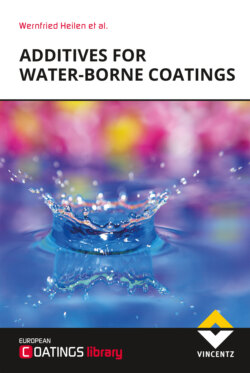Читать книгу Additives for Water-borne Coatings - Wernfried Heilen - Страница 8
На сайте Литреса книга снята с продажи.
2.1.1Pigment wetting
ОглавлениеThe process of wetting a solid by a liquid is summarised by Young’s equation:
γ s = γ sl + γ l • cosθ or
γ s - γ sl/γ l = cosθ
where γ s: surface tension of the solid, γ sl: interfacial tension solid/liquid, γ l: surface tension of the liquid, θ: contact angle solid/liquid, see Figure 2.1.
Figure 2.1: Equilibrium of forces according to Young
A contact angle of 0 indicates spontaneous wetting or spreading. The cosine of 0 is 1 and in this case the equation becomes:
γ l = γ s - γ sl
To achieve wetting the surface tension of the liquid must be lower than the surface tension of the solid.
A liquid with low surface tension wets a pigment surface better than a liquid with high surface tension. An additive which helps wetting must, as a first step, lower the surface tension. During wetting, the additive adsorbs on the surface of the pigment particles and forms an envelope around them. At this stage the pigment particles are still large. The interactions between these particles are lowered and the viscosity of the grind is reduced.
A reduction in grinding viscosity is a first indication of pigment wetting and incipient stabilisation. Optimal grinding of pigments can only be achieved through very good wetting. In this context, optimal grinding means achieving the largest surface area possible. The larger the surface area, the more light that can be absorbed and the higher is the resulting colour strength.
This means that achieving the low particle size needed for optimal colour strength calls for the best-possible wetting; i.e. to increase the colour strength, it is necessary to improve pigment wetting.
The particle size also determines transparency and hiding power. While organic pigments show a higher transparency at lower particle size, inorganic pigments have a maximum hiding power at a particle size of λ/2 [1].
